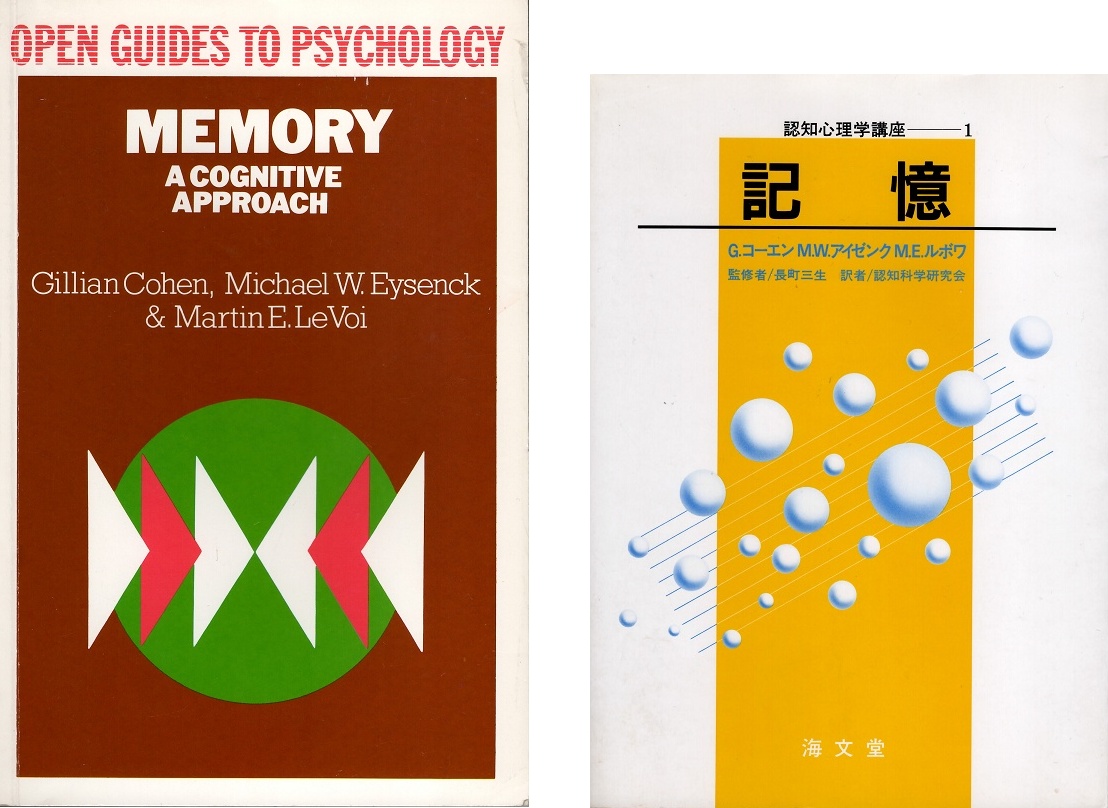(この解説は,「記憶の再生について考えるブログ」で記述した内容を,時系列で配置し直したものです)
スキーマについては,様々な説明がネット上でなされていますが,ここでは認知心理学の立場から,学校教育関係者向けに書いています.
ここでのスキーマについての説明は,次の論文がもとになっています.
RUMELHART,D.E. and NORMAN,D.A.(1983)'Representation in memory' in R.C.Atkinson,R.J.Herrnstein,G.Lindzey and R.D.Luce(edu)Handbook of Experimental Psychology,Wiley and Sons.
和訳 「記憶における表象」実験心理学ハンドブック
著者である RUMELHART,D.E ルメールハートは,アメリカの認知心理学者でニューラルネットワークの研究者です.

NORMAN,D.A. ノーマンは,アメリカの認知科学者,認知工学者です.

この2人が書いた,「記憶における表象」という論文を引用してスキーマの説明をしたのが,次のテキストです.

左が原著で右が訳本となります.
Gillian Cohen , Michael W. Eysenck , Martin E. LeVoi, “MEMORY : A Cognitive Approach” , Open Guides to Psychology , Open University Press, 1986.
日本では,右の訳本が有名ですが,基本的には大学院生から研究者用として書かれていますので,読んで理解するには,どうしてもそれなりの知識が必要となります.
ルメールハートとノーマンが考えたスキーマの特徴は,次の5項目で説明されています.
それぞれの項目に,ブログでの説明のリンクを張っています.
スキーマの5つの特徴
(1. スキーマは,「A」という文字の形についての単純な知識から,ピクニックや政治的思想のようなより複雑な知識,そして自転車に乗るとかボールを投げるとかいった運動行為についての知識に至るまで,あらゆる種類の知識を表象する.)
(2. 幾つかのスキーマは,まとまって関連するシステムにリンクされます.全体的なスキーマは,サブスキーマの集合で構成される場合があります.ピクニックスキーマは,「食事」,「遠足」,「パーティ」を含む,より大きなスキーマのシステムの一部である可能性があります.1つのトピックに関する知識のパケットは,関連するトピックに関連する知識のパケットにリンクされています.)
(3. スキーマはスロットを持ち,そのスロットは固定された強制値で埋められることもあれば,可変のオプション値で埋められることもある.例えば,ピクニックのスキーマは,場所,食べ物,人,アクティビティなどのスロットで構成される.場所のスロットは(定義上)固定値'outdoor'を取り,オプション値(森,川,ビーチなど)を追加することができる.食べ物,人などの値もオプションで,特定の機会に応じて入れることができる(図1.4参照).スロットはデフォルト値を持つこともできる.つまり,スキーマは,特定の情報が不足している場合に,スロットがどのような値を取る可能性があるかを教えてくれる.図のエピソードでは,食べ物が指定されていないので,スキーマは食べ物スロットのデフォルト値として「サンドイッチ」を提供しています.)
(4. スキーマには,個人的な経験から得た一般論と教えられた事実など,私たちが蓄積してきた全ての種類の知識を組み込んでいる.)
(5a. 異なるレベルにある色々なスキーマが,新しい入力を認識し解釈することに,積極的に関わっている可能性がある.ボトムアップとトップダウンのプロセスは繰り返され,新しい入力の最終的な解釈は,どのスキーマが入力された情報に最も適合するかによって決まる.例えば,芝生の上に座っている人たちを見たら,まずピクニック・スキーマを起動させるかもしれない.しかし,ボトムアップの情報によって食べ物の代わりに横断幕が見つかったら,ピクニックの代わりに「デモ」のスキーマに移行するかも知れない.この場合,デモ・スキーマが最適であることが判明し,優位で,最も活性化されたスキーマとなる.)
(5b. ボトムアップとトップダウンのプロセスは繰り返され,新しい入力の最終的な解釈は,どのスキーマが入力された情報に最も適合するかによって決まる.)
This list of characteristics defines a schema in broad general terms. More closely specified versions of schemas are called scripts (which consist of general knowledge about particular kinds of events) and frames (which consist of general knowledge about the properties of particular objects and locations). For the moment we can use the broader term 'schema' to cover the whole range of stored general knowledge.
(この特徴のリストは,大まかな一般用語としてスキーマを定義する.スキーマをより厳密に特定したものは,スクリプト(特定の種類の事象に関する一般的な知識で構成される)やフレーム(特定の物体や場所の特性に関する一般的な知識で構成される)と呼ばれる.今のところ,保存された一般的な知識の全範囲をカバーするために,より広い「スキーマ」という用語を使うことができる.)